JOHN RETSEK: THE CAR SHOW
This article is from our archives and has not been updated and integrated with our "new" site yet... Even so, it's still awesome - so keep reading!
Published on Tue, Jun 13, 2006
By: The LACar Editorial Staff
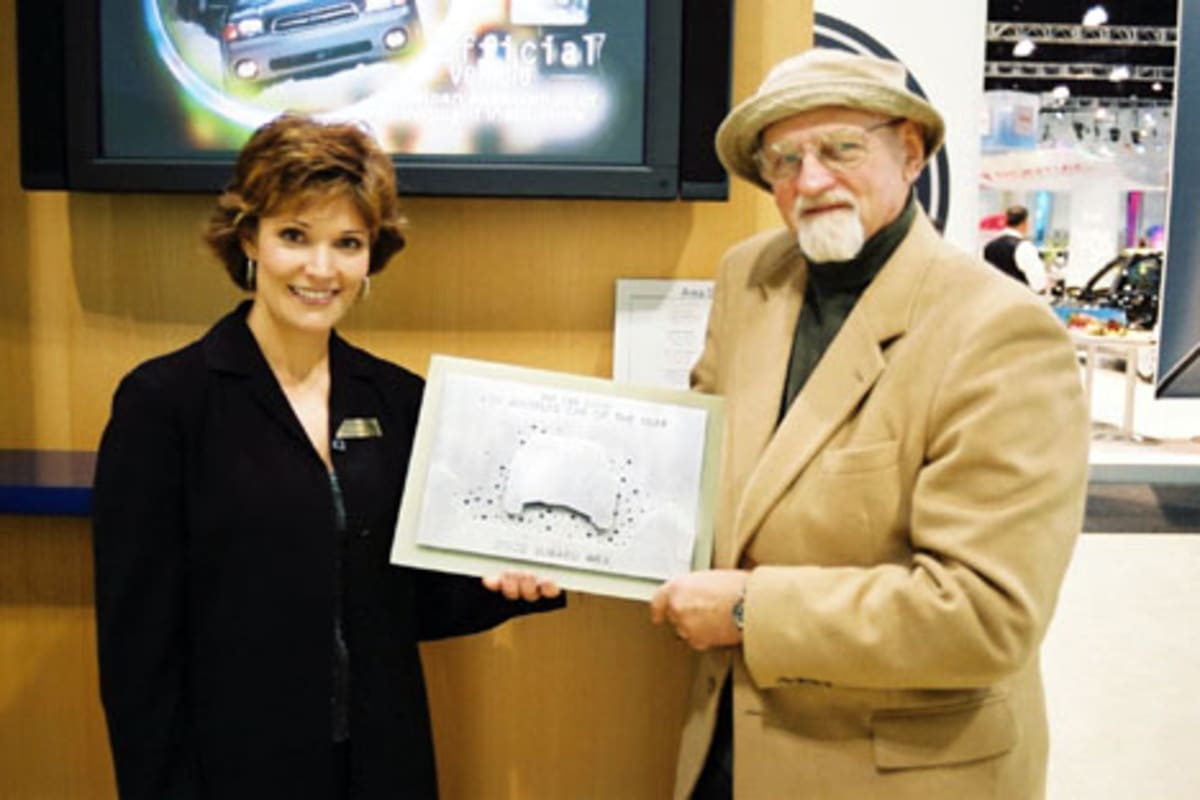
Retsek gives the LA Car of the Year award to Subaru
An Interview with John Retsek of KPFK's "The Car Show"
Since 1973, KPFK's The Car Show has been broadcasting candid information on virtually anything automotive. As a noncommercial program that accepts no advertising, it's a home to no one but its hosts, John Retsek and Art Gould, who hold nothing back in the way of opinions. Topics span the entire automotive spectrum from driving reports, to racing
news, to legislative updates, to inside industry information.
John Retsek started the show in 1973. He was a regular writer for the late and lamented Sports Car International. Retsek is a man of many hats. A former union man, John now earns his keep at KCET Public Television. He won a string of Emmys for his work as the Art Director for KCET. When he's not talking cars, he goes sailboat racing and classical concert halling.
"What impresses me so much about John is his passion for everything he does," says Matt Stone, Executive Editor of Motor Trend.
"I congratulate John for starting The Car Show and sticking with it all these years against all odds," says Chris Poole, West Coast Editor for both Consumer Guide Auto and Collectible Automobile magazine. "It's a great institution unique to Los Angeles, one that serves consumers and car nuts so very well."
"John is a wonderful conversationalist, which is one of the many things that makes him good on the radio, and he'll fight to prove his point, yet keep an open mind to someone else's. He's unselfish, welcoming guests and guest-hosts
into the studio, never concerned that they'll upstage him, and only wanting to make the show better with more viewpoints, voices, and experiences," adds Stone. "John's knowledge is so deep on so many things, and he works hard to stay current on whatever it is he's interested in."
LA Car's Roy Nakano and Bill Wright sat down with Retsek at his KCET studio to discuss his past, his present and The Car Show.
RN: John, what do you do when you are not doing The Car Show?
JR: I race a sailboat. I like to go to concerts; I can't stay away from the new Disney Hall. We have seats in the Terrace. I like to cook. I live through one remodeling of my home, but I am now designing a new edition to our house.
RN: What exactly do you do at KCET, and when did you get started there?
I started in 1969 at KCET, when it was on Vine Street. I'm involved in production design, but I do a lot of other things too. Right now, I'm the archivist, and reorganizing the tapes. I've had a series of jobs. I used to work on a production that was the only drama show that PBS produced; it went for over a decade. In 1971, we moved over to this lot (Editors: 4401 Sunset Boulevard). A high point was when we produced the set for Cosmos. That show was produced right here and in different locations. It was a lot of work. I've done dozens and dozens of other sets.
RN: Your background includes everything from television, to sailing, to union organizing. How did you get involved in automotive journalism?
JR: KCET in the early 1970s had a local news show. The producer and I were both interested in cars. I used to have several cars stashed around the lot (I only have one now). So we did some car reporting. There was a young woman, Wina Sturgeon, then wife of science fiction writer Ted Sturgeon, who did Helpful Hints on consumer products and she had a show on KPFK. She noted my interest and asked, "Why don't you come on my show and field some questions about cars?" I think that was in the Fall of 1972. I did the show with Jack Kirkpatrick, a friend and head mechanic for the California Highway Patrol. We had a lot of fun on the radio. It occurred to (then) Program Director Ruth Seymour (then known as Ruth Hirschmann), now with KCRW, that this could be a show for KPFK. So she approached us about having our own show on Saturdays for an hour. Jack and I thought that would be fun.
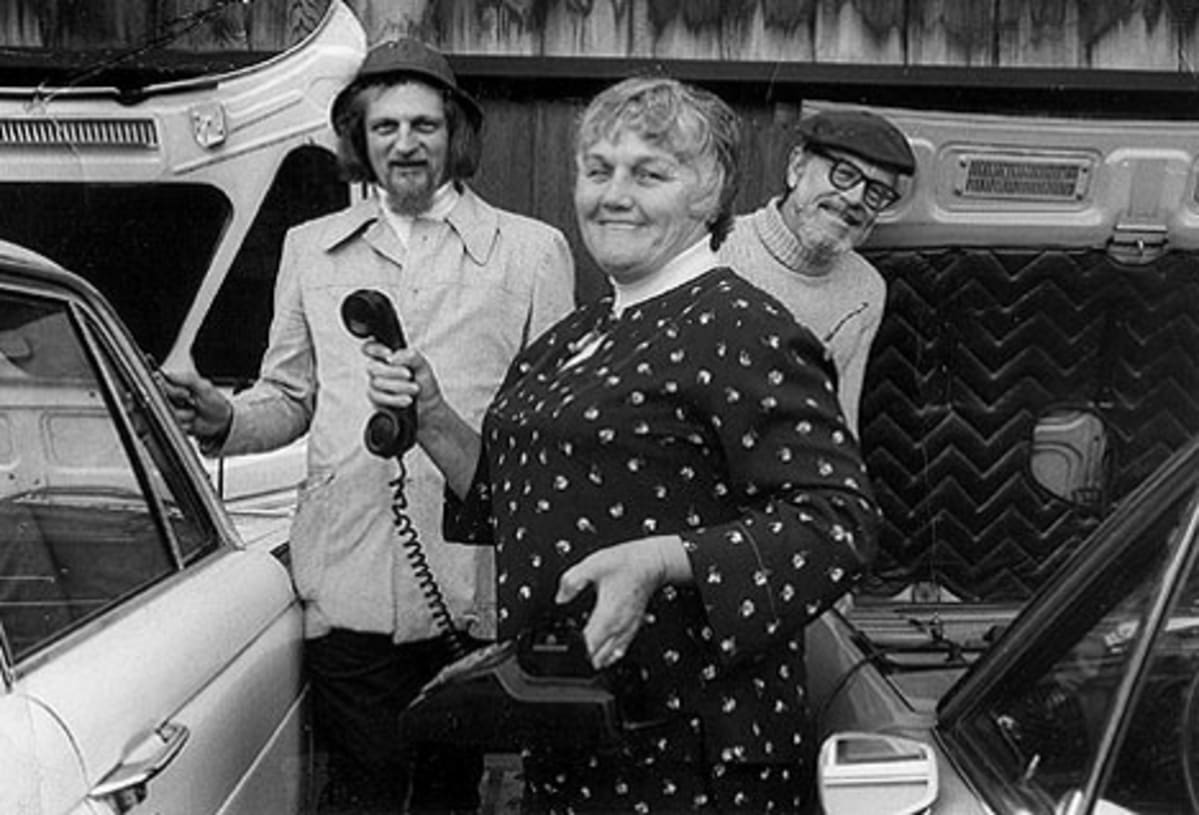
Yes, that's John on the left and Jack on the right.
BIRTH OF THE CAR SHOW
About a month or two after the show debut, we were getting calls from handlers of dealers who would track us down. Dealers were offering cars for us to drive. In fact, dealers gave us some of the cars. Audi at that time didn't have a press fleet handler. So it got even more fun.
Unfortunately, Jack was transferred by the Highway Patrol to San Luis Obispo. After about two years on the show, Jack decided to retire and move. His wife was our original telephone producer. I haven't heard from Jack in a couple of years, but I hope he is still messing around with cars. He is really a bright guy. Our theme music (Artie Shaw's "Summit Ridge Drive") was Jack's idea. Art (Gould) says there are so many car songs out there that we could play a different song every week, but I'll never change it.
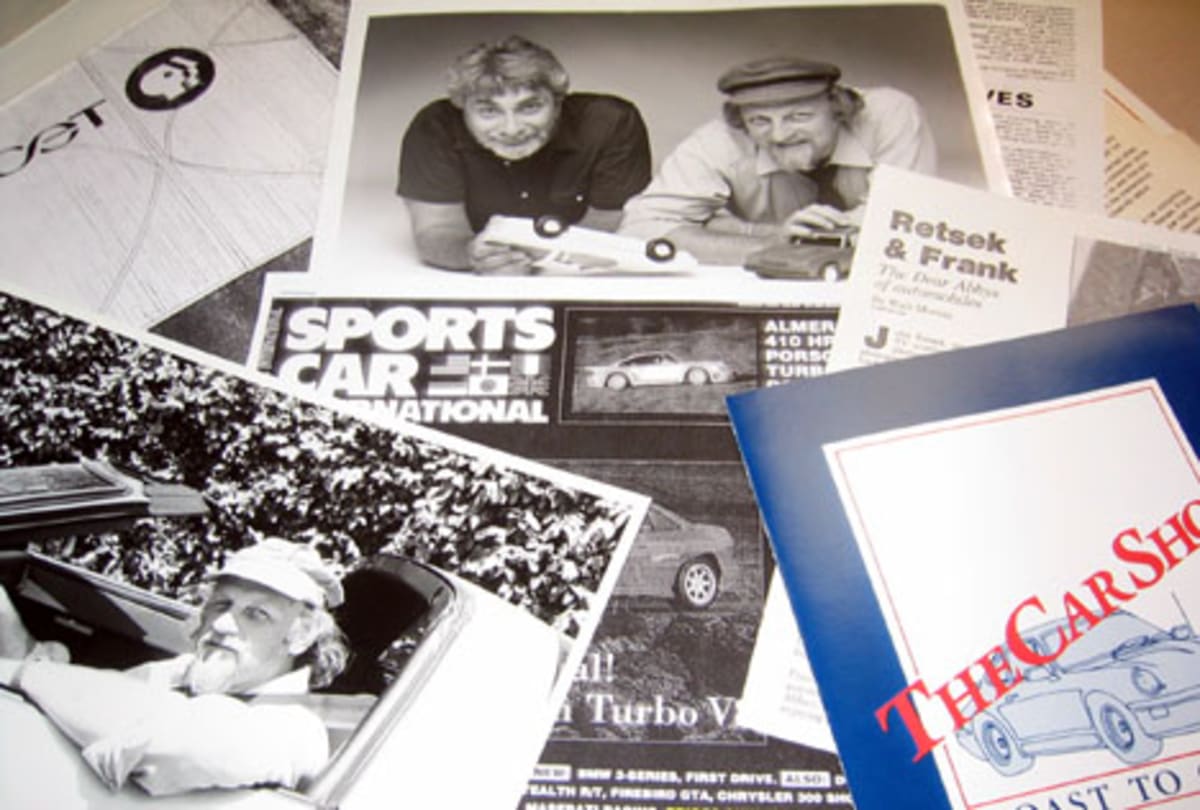
Top-Center: Len Frank and John Retsek
PARTNERS IN CRIME
So, I was by myself and started a city-wide search for a partner. I tried out several people and had hoped to find a woman's voice. On one of those shows, I came across Leonard Frank in Long Beach. He listened to the show and even called in several times. He was of the firm belief that that he knew more about cars than both Jack and I put together, which was probably true. Leonard and I found out that we both owned Berkeley Spyders. It was apparent we were destined to be a pair.
It was one of the smallest cars ever, and shaped liked a darling Ferrari. Both Leonard and I both thought the Spyder would have the dual purpose of being both a street car and a race car - it was neither. I had a 560 with three cylinders. There are still some of those running around. It was a lot of fun but you had to have a crazed existence to drive that around. It was quite a coincidence.
RN: So, that's how you hooked up with Len Frank. What about your current co-host, the artful Art Gould?
Art was general manager of Cormier and retired early. Until I gave him my old one, he didn't have a CD or DVD player in his house. He doesn't own a computer. He doesn't even have a street address. He does write for the Washington News. He's owned a couple of expensive cars, including a 427 Corvette that I've used as a prop on a set a couple of times.
RN: I enjoy Art's humor on the show. When did he come on board?
Art Gould started with us around 1990 as an expert on the retail car business. Both Len and I liked him a lot because he is a funny guy. We wanted a third person, just like Chris (Poole) is our third person now. One thing about Chris is that he doesn't like to fly to press events. If the two hosts are gone, then the third person can put together the show. Art used to be so shy on the show, you really had to work to drag him out. Now you can't shut him up (laughs). He's a very good guy and very knowledgeable. He is a rock.
RN: I've enjoyed the show's entire cast of characters over the years: BJ Killeen, Matt Stone, Greg VonDare, Chris Poole.
JR: Chris is one of my favorite cadres amongst local journalists. Greg VonDare, another go-to host, was a journalist who has since gone back to his first love, directing. BJ is co-host and road test editor of Drivers Talk, the Kern News station. Matt is the executive editor over at Motor Trend.
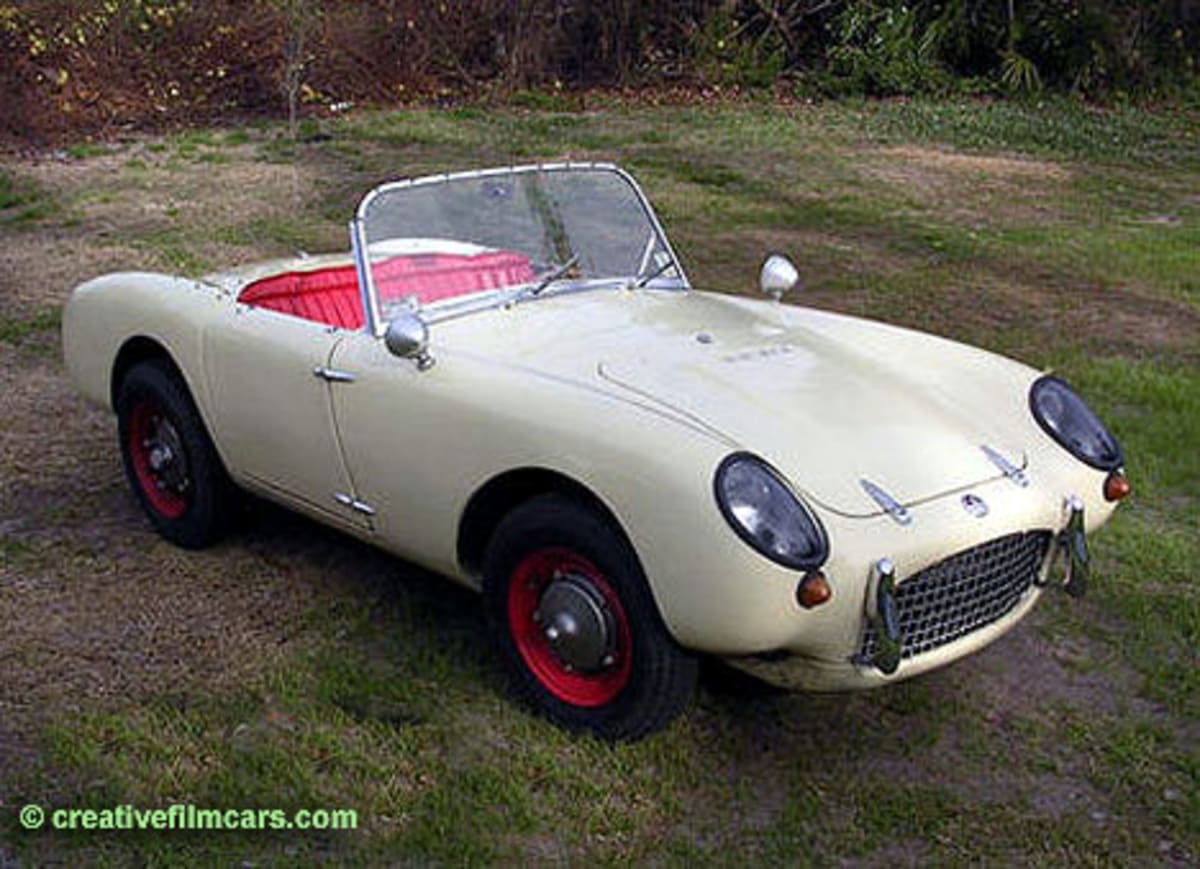
"John's collection of past cars have included some bizarre (mostly foreign)
examples of cars that go slow but get around corners real well." -Art Gould
Above: The Berkeley Spyder - mutually loved by John and Len
LEN'S LAST DAYS
RN: Len Frank was your co-host for over a decade. I always admired his storytelling skills and the wealth of car information he had stored up in his brain. Then, in the mid-1990s, you had a string of guest co-hosts in his absence. I never thought there might be something wrong until the day you announced that Len was very ill. How did you find out about Len's illness?
JR: The first phase of Len's illness was colon cancer. It was bad. He was aware of its seriousness. He received good care and wore the bag. He was advised to follow it up with chemotherapy. What are the odds of further cancer? He was told 50 percent, so he opted not to get treatment. By 1995, they found cancer in his lower spinal area.
Coincidentally, at about the same time, I had these curious lumps in my neck. I had two biopsies, and they diagnosed it as Type A lymphoma. So there we were - both of us sitting on plastic cushions. We had a lot of fun with it, but it wasn't funny. By December, Len was almost indisposed. He continued doing the show through February, but by March, he really had to be brought down lying in a station wagon. Of course, I'm zonked out due to the "chemo from hell" through April. Then, I had spinal injections. And, of course, during that time, Len died - June 6, 1995. Len's ashes were scattered out by his son, Stephan, on Turn Nine at Willow Springs Raceway through the roof of a Porsche 911.
Well, it's been ten years of remission for me.
Bill Wright: Before he met you and joined The Car Show, what was Len's day job?
Len was a car salesman. He actually had a dealership in Riverside, selling Saabs. He did have a Borg Worg in Ohio. He lost it on the I-6, coming off the iced road into a lake. He managed to get out alive. He also had taught English at Idaho State.
Len owned several cars, including a Corvair. When I met him, he had a Corvair that didn't run. That was the other thing we shared. We both owned Corvairs. I actually had several on the studio lot, in various stages of restoration.
BW: Gee, I would think that's something you couldn't have at a public radio station. They're "unsafe at any speed" you know (sarcastic).
JR: I had an opportunity a couple of years ago when Ralph Nader was here to actually confront him with a copy of his ("Unsafe at Any Speed") book, have him sign it, and give him a hard time. It was a dream of my youth. It was, for me,
like meeting Briggs Cunningham and doing his biography, or sailing with Dennis Conner on the America's Cup. It was my third most important goal in life (laugh).
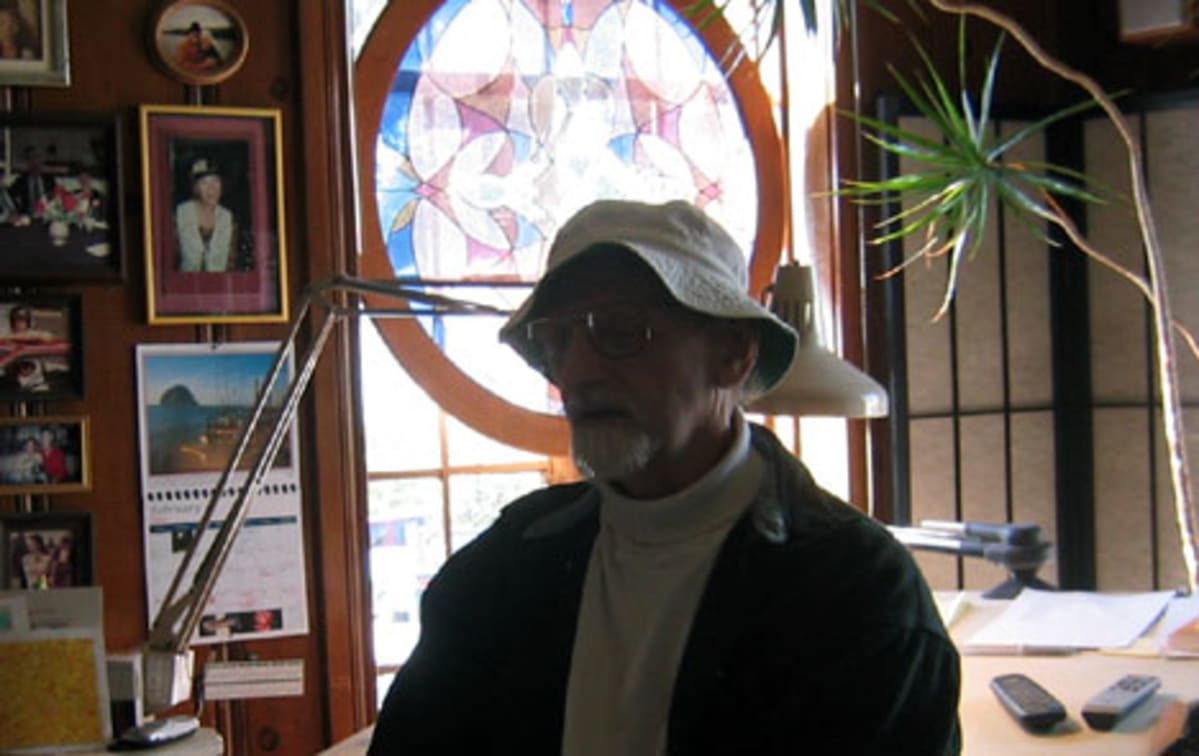
SAILING MISADVENTURES
RN: Speaking of unsafe at any speed, I read in a San Pedro publication of another near-death experience you've encountered.
JR: Oh yeah. In fifty years, I've never been seriously hurt sailing. You know how in California we have this benign and predictable weather. Well, on February 4, 1998, we were in the midst of El Niño. Heavy weather was looming, but we were heavy weather sailors from San Pedro. We're used to it; let's go out and sail around. We got out about three feet out of our slink and got hit by a microblast. We got spun around, so I went to release the main. I released the rope clutch and it got jammed, spinning us around even further. The last thing I remember is standing there looking at the main and wondering why it wasn't coming down. The next thing I know, I'm on the dock being treated. For a couple of days, I was in an induced coma. It was a good whack. I didn't break anything, but I did crack my skull and got a concussion. It took me a while to not be dizzy. It actually sort of healed.
I don't like telling people that story. I mean, an accident three feet from your slip! It's one thing to get knocked up while you are out to sea, but I didn't even get out of the channel! (laugh)
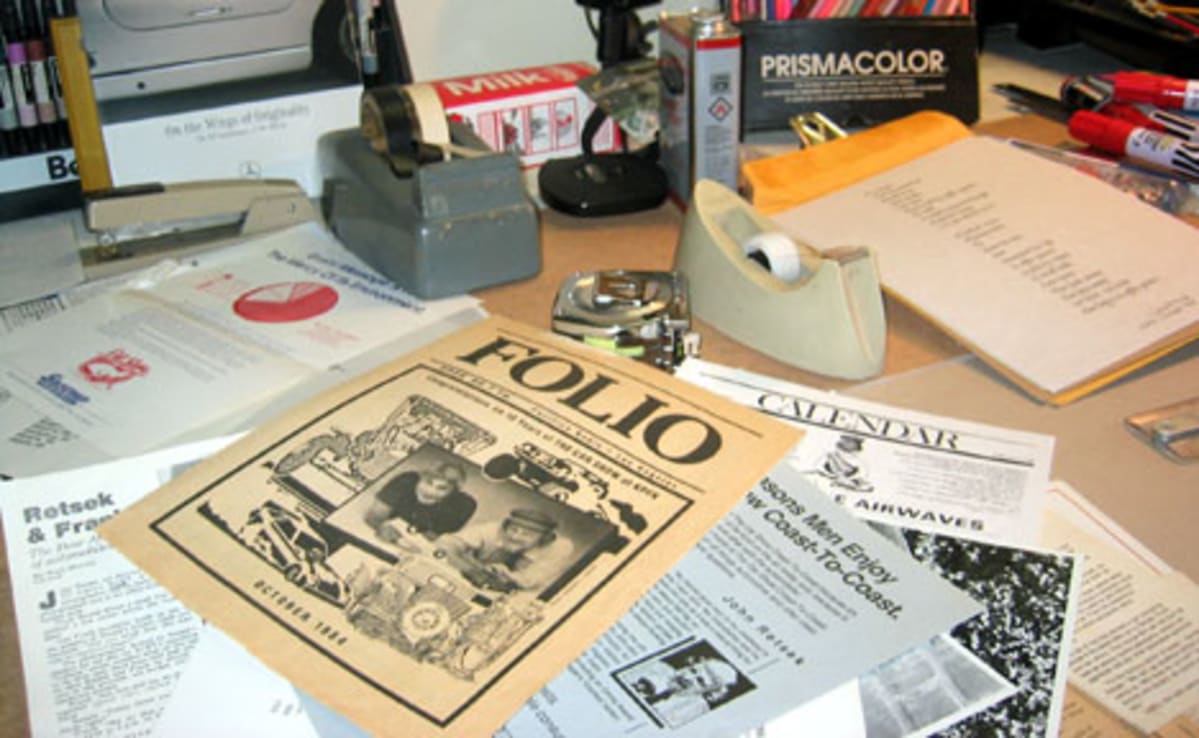
THE REVOLUTIONARY WILL NOT BE TELEVISED
BW: So the reduction of the show from two hours to one hour caused the end of call-ins. What exactly happened causing the show to go from two hours to no hours to one hour.
JR: Actually, it never went to zero hours. It was threatened, but it never actually happened.
RN: That was a couple of years ago?
JR: Yes, the problem was, of course, comrades, "The Revolution." This happened primarily because of our sister station in Berkeley, KPFA. KPFK was really singing along. We had a real, professional organization at KPFK. Where do you
think we got the money for the new studio, the new transmitter, and new antenna? Why, it was from the running dog capitalist pigs that got thrown out of there when The Revolution came. Of course, now they're standing back, taking credit for it and raising lots of money.
BW: Why has The Car Show stayed with KPFK? Why not another radio station?
JR: Ruth Seymour has approached us on a couple of occasions to go down to KCRW, but I've always managed to work with The Regime. And when they went, I stayed. I figured I was better off where I was - particularly after Matt Troubin (sp?) came in and started running it like a real radio station. But the revolutionaries up in Berkeley, which probably has had more broken glass and smashed down doors than any other radio station in the history of broadcasting
(laughter), saw it as a problem
Walkouts. They saw it as a problem. And the problem consisted of the idea, that somehow or another, we had to have a sacrosanct mission statement. That's the way the station had to be run, and we were going to return to that. The station was to be a democratic radio station. That scared the hell out of me because I have never done anything with democracy. Liberals usually are somewhat fascist (laughs). Suddenly all these people who had disappeared were picketing our station like it was back in the 1960-70s. Some people perceived The Car Show as problematic because it carried voices from the entire political spectrum. Even people from the far right were on The Car Show. On the other hand, we are raising some pretty significant money for the station.
But all the elections, politics, and board meetings prevented us from doing offensive things on Saturdays when they were having meeting. So some of the high rollers at the station were interested in cars and supported the show. So I get
a call back, "I'm sorry but we want you back. But we can only give you an hour because we scheduled something else in your time." They were begging.
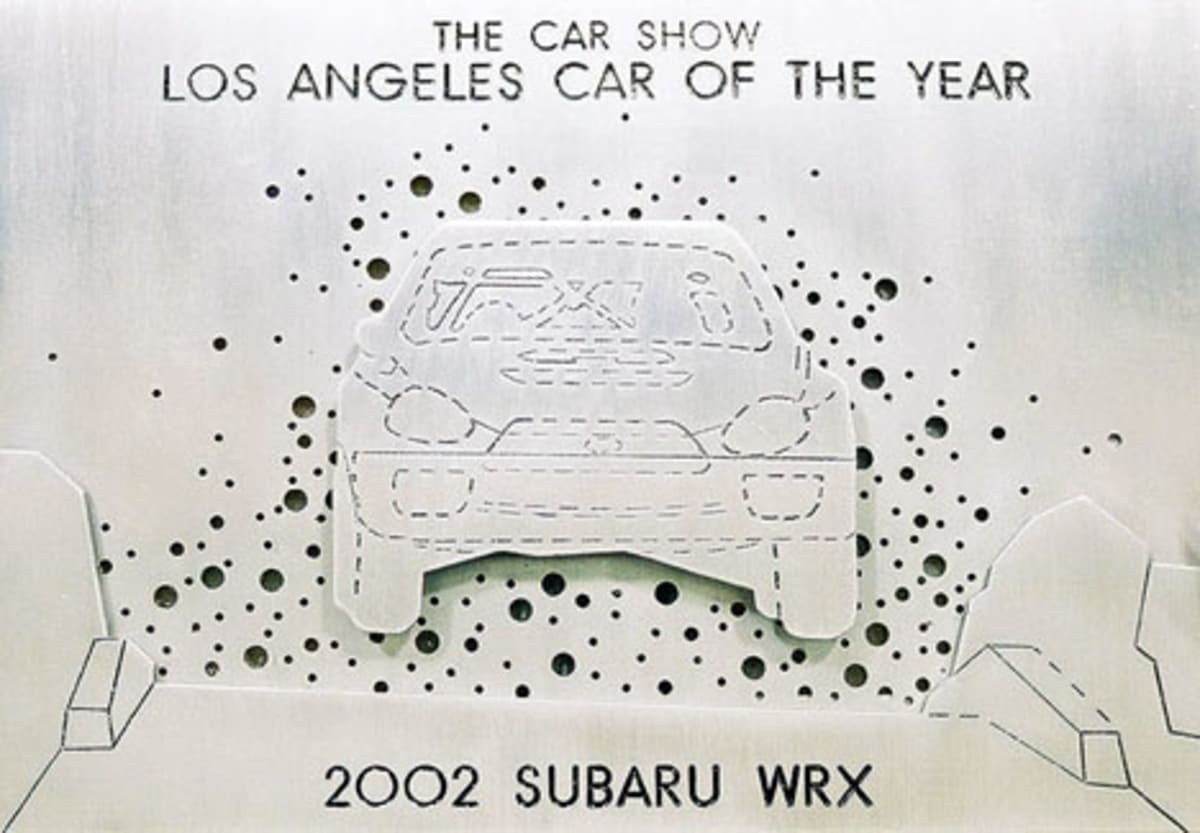
The "LA Car of the Year" award was an integral part of the 1997-2002 Car Show
BW: When you do the fund drive, how does the show do?
We do pretty good. We can usually make.. This last time we had good premiums and they were going well for $100 pledges. Art and I support the premiums by printing tee shirts. We focus on getting a lot of $50 pledges with free tees for
The Car Show.
Tom Nixon used to follow us, and I like his music. Digital Village, the geek show, now does. I loved In Fidelity too. They are good people.
RN: Automotive journalists are stereotypically libertarians, independent thinkers. Do you see yourself as an anomaly in automotive journalism?
JR: In my mind, real liberals give both sides a voice and listen to both sides. I come from a family tradition of working class Democrats but I'm not very happy with the current leadership in Washington DC (Clinton) and at KPFK. I happily live in a working class longshoremen's community in San Pedro. But as an automotive journalist, I'm probably a capitalist with a capital "K". In automobile business, governments don't make very good cars. I'll take General Motors over the government any time. I know what GM wants to do and in the long run, they will produce a better and even safer car. The government should just advise car companies. I think the car companies have stepped up to the plate and have done a helluva job emission wise, safety wise. However, I sway back and forth. Car commercials certainly lie and cheat extravagantly, and do not give any information of value. I'm liberal in that I've never liked war. Even as a little kid during WW2, I never saw anything of value in war.
RN: Do you have a favorite part of the show?
JR: I do like doing the phone calls.
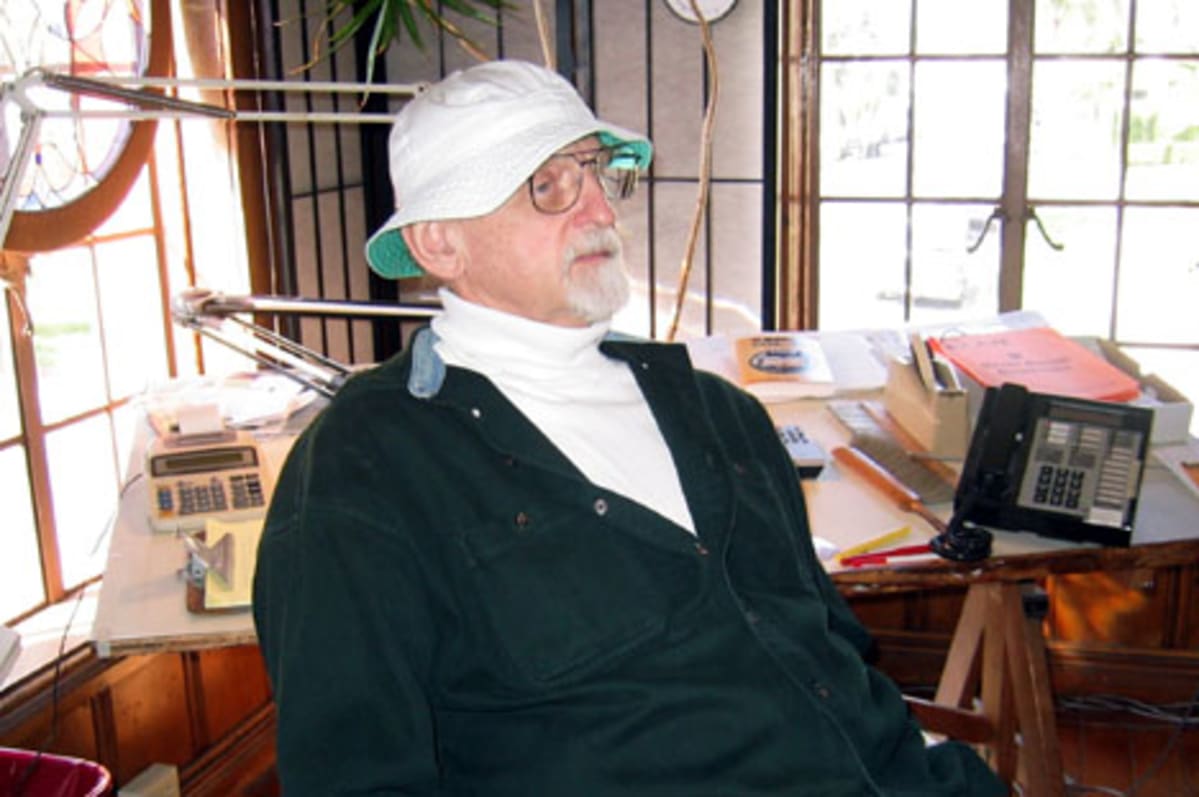
RN: Looking back on the Show's thirty-something years, what are some of the highlights? JR: In the last couple of years, I got to livecast from the 24-Hours of Le Mans endurance race. We loved to do dozens of bookstore shows where we meet people. This was at the Autobooks-Aerobooks store in Burbank. Famous writers would come down and even Jay Leno. KPFK used to do Holiday Faires with hundreds and thousands are watching you do the show live. But that was deemed to conflict with our non-profit status. It was fun and natural reaching out.
There were some other local car shows but they've come and they've gone. There was the truck show we did with Lance Likour (sp?), the Ragin' Cagin' Trucker. Our show went "Coast-to-Coast" for a while. And we tried to branch out to television. We did "Life and Times" with Pat Morrison.
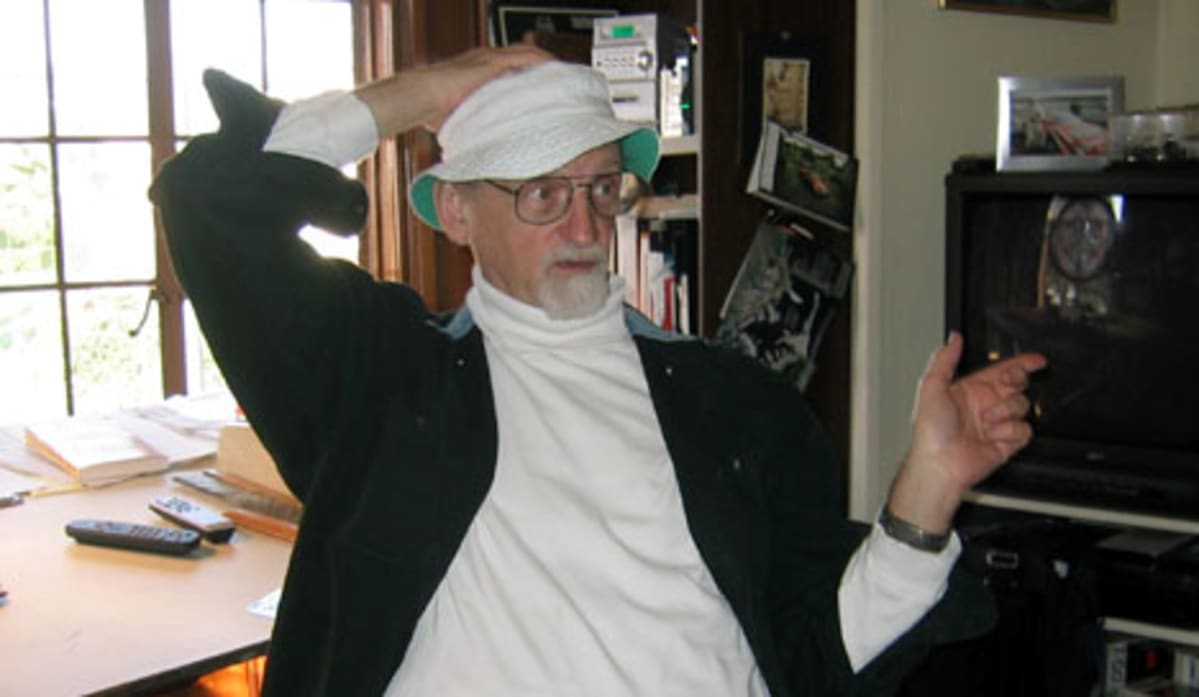
"HEY, YOU TOLD ME TO GO AHEAD AND BUY THAT M5!"
RN: Have you ever given advice that you later regretted?
JR: Oh, I'm sure. I probably recommended cars that weren't the right match. "I love my Z06 Corvette, but it's too much car for me." Occasionally, people call back and complain about my advice. One guy called and was determined to buy a BMW M5. I tried to talk him out of it, indicating that it was not the easiest car to drive. Ultimately, I relented and said, "Go ahead and buy it; buy the car you want - you can always sell it." He did buy it, and later regretted it. The car turned out to be the difficult steed that I said it would be. "But you told me to go ahead and buy it!" (laugh)
And I've given reviews of cars that were a bit too enthusiastic. The Chevy Citation X11 back in the 1980s, and received rave reviews all over - and we were participants to that. Why? The performance was like a breath of fresh air at that time. Of course, that was before I retested it and the hood of the production car came over and crashes back into the windshield - among other things. But compared to what GM had been doing, it was an attempt to catch up - a fun to drive car in the not-so-fun 1980s.
We did caution people about the GM X-cars, as they were called at the time - particularly the Cadillac Cimarron. It was really a Chevy with the doves on it. The chief engineer here bought one of those after I advised him not to. He said,
"But it was a Cadillac." He regretted it.
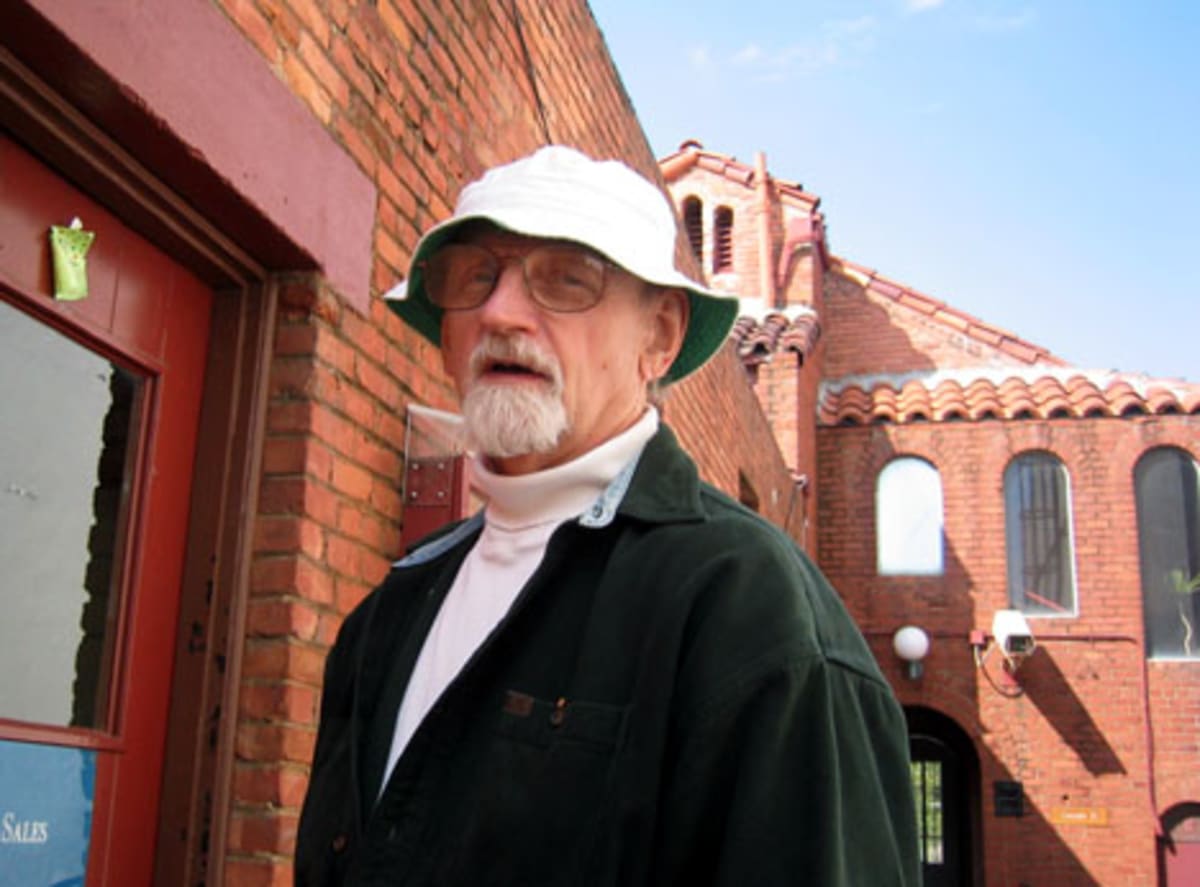
"A frequent guest, Dick Guildstrand, often reminds us 'there are sporty car
guys and there is the other group' - meaning high horsepower muscle car
types. Well, John is definitely the sporty car guy." -Art Gould
FUTURAMA
So, what's the future hold for John Retsek and The Car Show? There's no slowing down in sight. The Car Show continues to be one of the most popular programs on KPFK. John continues to race sailboats. Expect him to rack up a few more Emmys.
"John still finds fascination in the world, and just about the time when many guys, after so many years in the game, would be slowing down, he brings such great energy to his life and his many crafts," says Matt Stone. "His life is a colorful, painter's palette of knowledge, opinion, experience, enthusiasm, and genuine caring for people."
I so enjoy John's sense of humor and admire his intellect, thoughtfulness and obvious talent, adds Chris Poole. "I sense that he still greatly misses the late Len Frank; having known Len myself, I think they must have had a very special relationship: two fine minds, two passionate personalities. In any case, Len was one of a kind. And so is John."
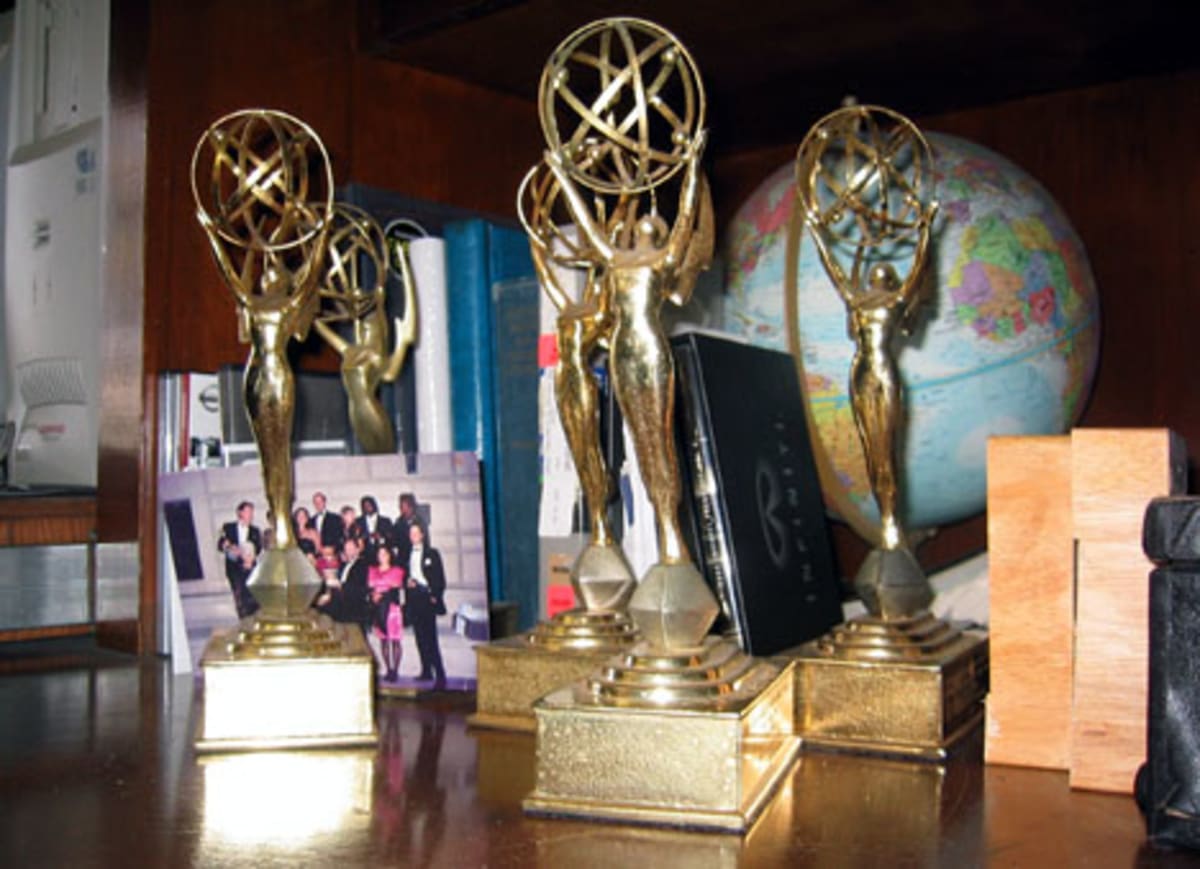
To find out more information on KPFK's The Car Show, go to The Car Show home page. To view the writings of Len Frank, go to Look Down The Road.




